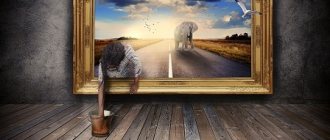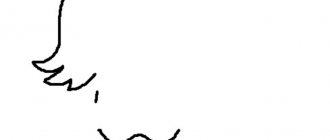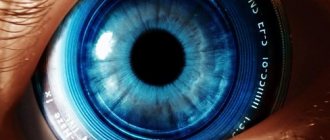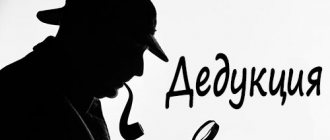Updated July 23, 2021 626 Author: Dmitry Petrov
Hello, dear readers of the KtoNaNovenkogo.ru blog. Creativity has become a fashion statement.
This concept is used as a personal characteristic, people are proud of it and justify any actions, and it is also an item in many resumes.
There is a strong belief that today we cannot do without it, but knowledge here is limited to the vague “something related to creativity.”
Let's find out what creativity is and how to use this word correctly so as not to make a mistake.
Creativity is...
This term was originally introduced by the American psychologist Joy Paul Guilford in the mid-20th century.
The concept of “creativity” goes back to the Latin creative – “ creative ”, creatio – “ creation ”. It is a tracing paper from the English “creative” (creativity), if translated literally, you get the clumsy-sounding word “creativity” (“creativity”, as they corrected me).
This play on words is not without reason: the concepts of “creativity” and “creativity” are like two twin sisters who are similar in many ways, but have different characters.
For the first “sister” it is largely applied, associated with purposeful activity and volitional efforts. Creativity is associated with freedom and the absence of rigid boundaries.
In a broad sense, creativity is the ability to solve problems in a non-standard, witty, bold way, or create a new product using non-specialized resources or tools.
In everyday life, we encounter a concept that is close in meaning – ingenuity .
There are different points of view regarding the emergence of creative abilities. According to one version, they were formed gradually, over a long period, as a result of changes occurring in humanity (cultural, demographic, etc.).
It is believed that the ability to think creatively suddenly appeared about 50 thousand years ago as a result of a genetic mutation.
| Creativity: Thinking Out Loud |
- What is he doing?
- Looking for a car. - Lord, it’s not under a stone! - Lord, why not under a stone?! "Journey to Ixtlan" Carlos Castaneda
Recently, due to the development of technology, there has been an acceleration of all processes occurring in society. The world around us is becoming faster and faster and the speed is growing. Have you recently purchased a new management book? Hurry up to read it - it won’t be long before a new bestseller appears. Did you buy the latest mobile phone model in the spring? Go to a phone shop in the summer. Your new model is no longer new at all, and your tariff is outdated. Products, models, programs, concepts, tariffs (in Russia, and laws) change at enormous speed. Companies are forced to constantly improve their technologies, launch new products on the market, and generate new ideas. Hewlett-Packard makes most of its profits on products that didn't even exist a year ago. In 1996, Sony released 5,000 new products, which is more than two products per hour! To survive in this rapidly changing world, you need to constantly change yourself, find something new, and create. Creativity is no longer a specialty of people of art; being a creator is vital for a manager, programmer, marketer, trainer, sales representative... More and more often, employers indicate such a requirement for a candidate as a creative approach, creativity. Creativity has become the key to successful activities in our rapidly changing world.
So, let me introduce - creativity.
Creativity is a person’s ability to engage in non-standard, original thinking and behavior.
At the same time, it is necessary to note the creative, constructive nature of such thinking and behavior. Creativity manifests itself in many ways: originality and quick thinking, the ability to find unexpected solutions in a seemingly hopeless situation, a rich imagination, a sense of humor, and the creation of new original products (physical and intellectual). Is creativity an innate quality or does its development depend on upbringing or training? Why are the actions of one person a constant source of new ideas, approaches, solutions, while another, on the contrary, is characterized by standardness in everything, in thoughts, actions, decisions?
Indeed, creativity largely depends on innate qualities, however, the development of a person’s creative thinking is mainly determined by the environment in which the person developed, the extent to which this environment stimulated creativity, supported and developed the person’s individuality. There is evidence that between the ages of 6 and 7, creativity decreases by 50%, and by adulthood by another 30%. Our source of living creative energy is gradually being swept away by the sands of common sense, rationalism, and stereotypes. But the source is in each of us! The question is to remove the barriers and allow it to flow freely into our lives again, sparkling in the sun.
Speaking about the development of creativity, perhaps, first of all, it is worth talking about the barriers that prevent the manifestation of our creativity.
During a training on developing creativity, the trainer draws three circles on the board (Fig. 1) and gives the following task (the task is given orally): “Add something to these three circles to make two.” The group begins work: someone tries to turn these circles into wheels, completing the drawing of the car, someone turns one of the circles into a square, someone folds the sheet so that one circle overlaps the other, someone simply tears off the “extra” circle .. But none of these decisions satisfies the coach. And the participants themselves feel that there is still something missing in their solutions: it seems that the problem has been solved, but it’s not that, that’s not it. The decisions lack beauty, precision, and grace.
And suddenly, “eureka!”, someone found a solution: these three circles are used as the basis for writing the word “two”. After all, the task did not say that there should be two circles left, just that there would be two (“two”). However, the participants assured that the instructions clearly stated “... so that there are two circles left.” In this example, we can see the effect of one of the barriers to creativity - the desire for certainty. A person does not like uncertainty and always strives to eliminate it. The condition of the problem sounds quite vague - so we’ll add the condition ourselves. Now everything is clear and you can calmly proceed to the solution. But, alas! By narrowing the formulation of the problem, limiting ourselves to additional conditions, too clear formulations, we closed the path to solving the problem for ourselves. Such things happen all the time, and most importantly, unconsciously! And creativity just loves uncertainty. Uncertainty is the oxygen that allows our creativity to burn brighter. The more uncertainty, the more opportunities to find a new, unexpected, fresh solution to a problem that seems to have been studied from all sides for a long time. For example, what is the best way to organize an office? Stop. Who said that everyone should sit together, that the office consists of tables, chairs, and papers? Where is it recorded? Down with certainty! A virtual office is a completely new solution to an old problem.
Another barrier to creativity is the fear of being judged by other people. In any new business, there is always a high probability of failure and error. Therefore, we often prefer to do something the old proven way rather than experiment in the hope of success. Believe it or not, there is a company where mistakes are encouraged and when summing up annual results and distributing bonuses, there is a bonus for the “mistake of the year”...
Stereotyped fragments of consciousness (age, gender, status stereotypes, unshakable ideas, principles, habits, etc.) significantly limit the field where a creative approach can be applied.
Low self-esteem and lack of self-confidence also become obstacles to the free expression of creativity in a person.
It is the presence in each of us of numerous barriers of this kind that prevents us from expressing our creative potential. Therefore, one of the key points of creativity development training is to understand your barriers to creativity and work with them.
However, it is not enough for a manager to just be creative; it is important to encourage and develop creativity in his employees. To do this, the manager must create an appropriate environment conducive to the manifestation of creativity - a creative environment. A number of characteristics of such an environment can be identified:
— Uncertainty — Problematic — Acceptance — Non-judgmental
It should be noted that each person is also an environment for another. Surely you have noticed that in the company of a bright, creative person, you yourself become more creative. A creative person attracts others, it is interesting to be with him. Like dancing flames, you never get tired of looking at him. So burn brightly and the people around you will become better, more fun, more creative!
Of course, in such a short article it is impossible to even fully cover the phenomenon of creativity. But there is another idea. I suggest you right now practice developing your creativity and experience the creative process “live,” so to speak.
To do this, you are asked to solve one management problem. (Similar tasks are used in creativity training.)
So, the task:
Imagine that you are the manager of two sneaker factories. Factories produce the same products. One plant is located in Yaroslavl, the other in Bryansk. Both plants have a common problem: due to theft, your company suffers significant losses every month. The regions are not rich, wages are low, and factory workers take out and then sell sneakers, thus receiving additional income. Many people steal simply out of an old “soviet” habit. One way or another, this problem is of such magnitude that it threatens the continued existence of your company. As a manager, you need to find a solution to this problem and stop theft completely. (It is clear that you have already taken some measures, for example, such as strengthening security and dismissing those caught stealing, but the consequences are worse than before.)*
Hint (on the solution process)
The process of solving a creative problem is called the creative process. This process has certain patterns, and knowing them helps to succeed in finding a solution.
Stages of the creative process.
1. Pseudo insight
When starting to work on a problem, several solutions immediately come to mind. However, more often than not, these solutions are not the real solution to the problem.
2. Problem analysis
At this stage, data about the problem is analyzed, compared, and reference is made to previous experience.
3. Frustration
At some point, your patience runs out and you decide to quit this stupid activity. In this case, there may be various reaction options: aggression (Here they have given a problem, the anchor is in their liver!!!), depression (Eh, I can’t do anything, and I won’t succeed... nothing... ever...), rationalization (Problem conditions formulated incorrectly, so there cannot be an adequate solution), other options are also possible, but in any case the result is the cessation of work on the problem.
The moment of frustration when solving creative problems is key. Here it is important not to give up this task, but simply leave it for a while, switch to another activity (at the same time, it is very important to maintain motivation for the solution)
4. Incubation
At this stage, you are not consciously dealing with the problem, but your subconscious is actively looking for ways to solve the problem.
5. Insight (illumination)
And then suddenly a decision comes to you. You didn’t even think about the problem; the solution seemed to come out of nowhere. The moment of finding the answer is accompanied by strong positive feelings. You don’t even need to check yourself - you know for sure that this is the correct answer.
6. Checking the solution
Here you still check how correct the answer is, how adequate your solution is.
I sincerely hope that knowledge about the creative process, about the barriers to creativity will help you not only solve the proposed problem, but also in the future, in your daily activities, you will be able to show your creative potential more often.
https://www.kreakratia.ru/
Discuss the article on the forum
What is creativity
In the 90s of the last century, thanks to the light hand of advertisers, a sonorous word akin to the concept in question appeared in the Russian language - “creative”. It is associated with a flow of creative ideas in connection with advertising texts, slogans and the like.
There is no clear definition of what creativity is. Initially, it gained popularity by replacing its Russian analogue - “fiction” . This word also means a product of human activity, created in a special way, using new approaches and creative solutions.
In business (usually advertising), creativity is solving a problem in a non-standard way, an original idea that solves the customer’s problem.
In this case, it is a really tangible unit that can be measured in ROI - the return on investment for the creation of creative advertising.
Part 3. What books to read
I'll be brief here. The Internet is full of reviews and reviews of these books. Some I have already read and are actively implementing techniques from there, others are waiting for their turn.
Vasily Lebedev. CRAFT Michael Micalko. Rice Assault Michael Micalko. Hacking creativity Edward de Bono. Genius Heinrich Altshuller. Find an idea by Mark Levy. Genius to order Dave Gray. Liminal Thinking Julia Cameron. The Artist's Path Gareth Moore. Lateral logic
Read books, practice techniques and use them to create creative solutions.
I hope this article has lifted the veil of secrecy over the concept of “creative thinking”. In my Telegram channel I write about training, development of cognitive functions and working with information. I will be glad to see all interested people.
A creative person from a psychological point of view
As a personal trait, creativity is actively studied in psychology. Experts are trying to figure out why for some it is not a problem to think in a non-standard way, while others are unable to move away from template schemes.
Psychologists have come to the conclusion that a creative person is distinguished by the following properties:
- Sufficient level of intelligence. An IQ score below 105 points is rare among such individuals, but high intelligence (IQ>120) is often accompanied by a decrease in creativity. Special tests have shown that the most optimal level of intelligence here is slightly above average.
- Flexibility of thinking, allowing you to skillfully act in situations of uncertainty, the ability to go beyond what is established, invented, or previously written.
- An attitude towards creativity as a life principle, an internal driving force, thanks to which creativity manifests itself in all areas of life.
From a psychological point of view, a creative person is a person who thinks outside the box and knows how to see a problem from different angles.
When making decisions, intuition is no less important for him than logic. He is not necessarily a creator in the generally accepted sense, writing paintings, poetry, music. Not only Van Gogh or Kafka can be called creative, but also a housewife who came up with a new super way of washing dishes.
About the perception of difficulties
If we list all the qualities of a creative person, this is perhaps the most surprising. In a difficult life situation, they are immersed in creativity, the pain seems to come out of them through what they create.
For example, the famous artist Frida Kahlo began her creative journey when, at a very young age, she was in a car accident and her body was completely in plaster. To somehow entertain herself, she began painting plaster, and later created world-famous masterpieces.
For a creative person, trauma becomes an extraordinary motivating force. In an effort to get rid of suffering, poets and artists look at the situation from the other side and amaze society with the greatest works of art.
How to develop creativity
A person engaged in the same type of activity (and these are the majority) “turns on” unidirectional linear thinking , which is detrimental to creativity.
But everything can be changed; there are simple techniques .
- "Unlocking" the brain. Watching films, programs that differ from the usual ones, listening to music that has not been heard before.
- Change of lifestyle. Even by changing your working hand while brushing your teeth or your usual route from home to work, you can make your brain work differently.
- New activity. An unusual master class, sommelier courses (how is that?), group classes in Zumba or cycling will pump up the “dormant” corners of the brain.
- “Recharging” with someone else’s creativity. A concert of experimental music, original theater productions, expressionist paintings are suitable...
There are special exercises to develop the ability to think creatively. They can really be “fitted” into your daily routine.
- Having opened the refrigerator, instead of grabbing a loaf of sausage with your teeth, you need to evaluate the contents and come up with a new dish from the available products. Even if, in addition to the mentioned sausage, there will be a wilted lettuce leaf and 3 olives - this is an excellent reason to “pump up” your creative abilities.
- Having fixed a white sheet in your imagination, mentally write your name using colored paints, “touch” the inscription, feel the texture, smell. Finally, erase.
- Think about the problem to be solved in the rhythm of dance - in spontaneous movement, trying to translate the thoughts swarming in your head into body language. This is called "dancing the problem."
- Taking a book or dictionary, choose 2 words at random, and then find (or come up with) something in common between them. Perhaps an incredible and even crazy story will be born.
Excellent ways to “pump up” creativity are learning foreign languages, traveling, in other words, constantly expanding your horizons. For example, if you find “Doctorskaya” sausage in the refrigerator, immediately find out where this name came from.
Creative in the professional sphere
Highly valued in many professions, creativity has considerable practical significance. Photographer, marketer, designer, event organizer, SMM manager - the list of specialties that require creative individuals can be continued for a long time.
There are calculations showing that in the near future up to 60% of professions will become unclaimed - people will be replaced by robots. Only those areas where creative thinking is required cannot be replaced by artificial intelligence.
The staff of advertising agencies, design studios and other similar places often has a “profile” position - creative director. He leads art groups, generates ideas, and is responsible for the final creative product.
Creativity has become a “stamp” on the resumes of a variety of professions, from general director to manager. What do employers mean by this quality, and how to avoid mistakes when filling out this column?
- The main thing is not to overdo it, relying only on creativity. Practice shows that most employers view this quality with a grain of salt. For example, a brand manager is, first of all, a person who masters brand promotion technologies, and only then a creative person.
- A statement about the ability to think outside the box must be supported by real creative achievements (as an option, use a self-invented slogan or logo as an example).
- It is preferable to decipher the concept indicating specific skills and abilities. “I can develop an unconventional product positioning strategy” - this phrase will convince a potential employer that he has a good employee in front of him and should hire him.
Not every position requires creativity from the person filling it. A creative accountant will most likely not please the employer.
Substitution of concepts
The word “creativity”, together with its cognates “relatives” (creative, etc.), is often used inappropriately, so it has acquired other meanings, in particular, it has become synonymous with absurdity and absurdity .
This is an unfounded substitution. For example, a person who wears strange-looking clothes may be driven by a desire for originality, a lack of taste or a sense of proportion, but certainly not by creativity.
This concept is used to justify erroneous decisions, actions, and actions. An unsuccessful haircut, a poorly tailored suit, an incorrectly executed document is a reason to hear: “ Nothing, but creative !”
There is also an ironic subtext. For example, a colleague hung a poster with strange content over his desk. What can I say about this? - “Creative!” Wanting to emphasize the “modesty” of the results of the creative process, they say: created .











